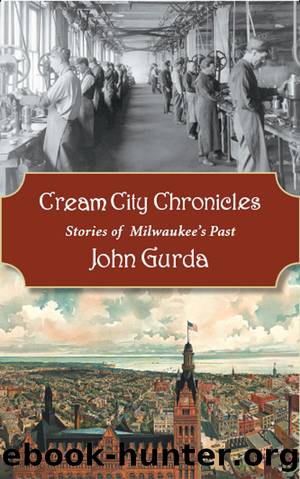Cream City Chronicles by John Gurda

Author:John Gurda
Language: eng
Format: epub
Publisher: Wisconsin Historical Society Press
Published: 2013-01-07T00:00:00+00:00
Milkwaukee Auditorium, 1909
If These Halls Could Talk
Milwaukee Auditorium Was Cityâs Parlor
Milwaukee suffers from an embarrassment of riches when it comes to entertainment venues. The Marcus Center, the Pabst Theater, the Bradley Center, the Arena, and the Milwaukee Theatre are practically neighbors in downtown Milwaukee. At the height of the season, when State Street is filled with pedestrians in a hurry, you canât tell if theyâre rushing to a Bucks game, a ballet performance, or a Broadway show.
Weâve come to take this variety for granted, but it wasnât always so. Until the mid-1900s, the Milwaukee Auditoriumâ forerunner of the Milwaukee Theatreâwas the cityâs only central gathering space. It served as Milwaukeeâs front room, the communal parlor we gussied up to entertain out-of-town guests and receive special visitors.
The building was busy from the day it opened in 1909. In its first full year of operation, the Auditorium hosted 188 meetings, 57 trade shows, 44 concerts and dances, 35 conventions, 13 lectures, and 8 circuses. With typical Milwaukee modesty, the buildingâs managers claimed only that it was the âbest lighted and ventilated hall in the country.â
By the early 1920s, after some judicious improvements, Milwaukee was ready to crow with the biggest of cities. An elaborate brochure described the Auditorium as âThe Nationâs Meeting Placeâ in âAmericaâs Best-Equipped Convention City.â Hyperbole aside, the building was the scene of some red-letter events. In 1916, with war raging in Europe, local Germans staged a week-long âcharity war bazaarâ in the Auditorium to help the subjects of Kaiser Wilhelm. Its raffles, food booths, concerts, beer garden, and displays raised more than $100,000 âfor the relief of war sufferersâ in the Fatherland.
One year later, such an event would have seemed positively treasonous. America entered World War I on the Allied side in 1917, and Auditorium gatherings took a decidedly patriotic turn. In 1918, the United Slavs, a group headed by the cityâs Poles, drew 20,000 to a rally supporting the policies of President Woodrow Wilson, who had made Polish independence one of the warâs objectives.
With victory secured in November 1918 (an event celebrated at the Auditorium), Milwaukee turned to less momentous concerns. As the 1920s roared into high gear, the Auditorium was the scene of elaborate trade shows promoting radios, automobiles, and such home improvements as âdriplessâ electric refrigerators.
There were less salutary gatherings. The Ku Klux Klan rode a wave of intolerance to new heights in the wake of World War I, and Northern cities became its particular strongholds. In 1922, nearly 3,000 Klansmen converged on the Auditorium to hear a message of hatred directed against Jews, Catholics, African Americans, and immigrants from anywhere.
The building was quieter during the depressed 1930s, but it remained Milwaukeeâs place for civic celebrations. One of the most spirited marked the end of Prohibition in 1933. Nearly 15,000 people jammed the Auditorium for an old-fashioned âVolksfestâ featuring sauerkraut, frankfurters and, for the first time since 1919, legal beer.
War clouds soon returned and, once again, not every Milwaukeean was on the right side. In 1935, the Friends of New Germany staged an Auditorium rally in support of Adolf Hitler.
Download
This site does not store any files on its server. We only index and link to content provided by other sites. Please contact the content providers to delete copyright contents if any and email us, we'll remove relevant links or contents immediately.
| Americas | African Americans |
| Civil War | Colonial Period |
| Immigrants | Revolution & Founding |
| State & Local |
In Cold Blood by Truman Capote(3311)
The Innovators: How a Group of Hackers, Geniuses, and Geeks Created the Digital Revolution by Walter Isaacson(2845)
Steve Jobs by Walter Isaacson(2836)
All the President's Men by Carl Bernstein & Bob Woodward(2328)
Lonely Planet New York City by Lonely Planet(2172)
And the Band Played On by Randy Shilts(2130)
The Room Where It Happened by John Bolton;(2104)
The Poisoner's Handbook by Deborah Blum(2093)
The Murder of Marilyn Monroe by Jay Margolis(2059)
The Innovators by Walter Isaacson(2056)
Lincoln by David Herbert Donald(1945)
A Colony in a Nation by Chris Hayes(1881)
Under the Banner of Heaven: A Story of Violent Faith by Jon Krakauer(1750)
Amelia Earhart by Doris L. Rich(1650)
The Unsettlers by Mark Sundeen(1647)
Being George Washington by Beck Glenn(1622)
Birdmen by Lawrence Goldstone(1621)
Dirt by Bill Buford(1612)
Zeitoun by Dave Eggers(1593)
